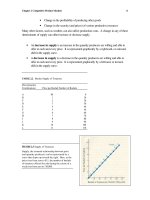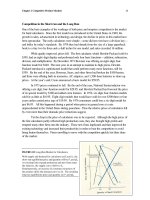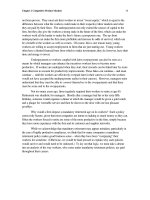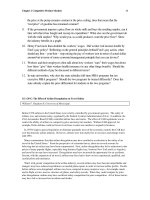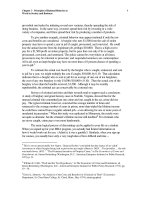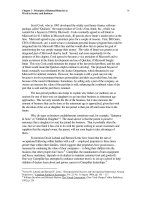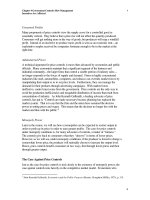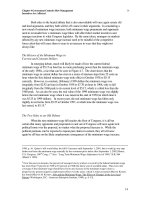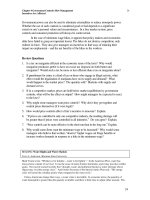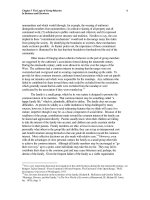Tài liệu Microeconomics for MBAs 12 docx
Bạn đang xem bản rút gọn của tài liệu. Xem và tải ngay bản đầy đủ của tài liệu tại đây (187.07 KB, 10 trang )
Chapter 4 Government Controls: How Management
Incentives Are Affected
4
4
Unearned Profits
Many proponents of price controls view the supply curve for a controlled good as
essentially vertical. They believe that a price rise will not affect the quantity produced.
Consumers will get nothing more in the way of goods, but producers will reap a windfall
profit. Instead of an incentive to produce more, profit is seen as an economic rent—an
exploitative surplus received by companies fortunate enough to be in the market at the
right time.
Administered Prices
A technical argument for price controls is most often advanced by economists and public
officials. Many economists maintain that a significant segment of the business and
industrial community—the larger firms that control a sizable portion of industry sales—
no longer responds to the forces of supply and demand. Firms in highly concentrated
industries like steel, automobiles, computers, and tobacco can override market forces by
manipulating their output so as to set price levels. Furthermore, they can manage the
demand for their products through advertising campaigns. With market forces
ineffective, control must come from the government. Price controls are the only way to
avoid the production inefficiencies and inequitable distribution of income that result from
concentration of industry. As John Kenneth Galbraith, a leading advocate of price
controls, has put it, “Controls are made necessary because planning has replaced the
market system. That is to say that the firm and the union have assumed the decisive
power in setting prices and wages. This means that the decision no longer lies with the
market and thus with the public.”
1
Monopoly Power
Later in the course, we will see how a monopolist can be expected to restrict output in
order to push up its price in order to earn greater profits. The case for price controls
under monopoly conditions is, for many advocates of controls, a matter of “fairness.”
The controls give back to consumers what they “deserve” in terms of lower prices.
However, as we will see, under monopoly conditions, if the producer is forced to charge a
(somewhat) lower price, the producer will rationally choose to increase the output level.
Hence, price controls benefit consumers in two ways, first through lower prices and then
through greater output.
The Case Against Price Controls
Just as the case for price controls is tied closely to the existence of monopoly power, the
case against controls rests heavily on the competitive market model. Economists who
1
John Kenneth Galbraith, Economics and the Public Purpose (Boston: Houghton Mifflin, 1973), p. 315.
Chapter 4 Government Controls: How Management
Incentives Are Affected
5
5
oppose controls feel that competition is sufficient to govern business behavior, including
pricing decisions. Opponents of controls also stress the individual’s right to act without
government interference—a right they see as crucial to a society’s ability to adjust to
social and environmental change.
When we say that the prices of certain products should be controlled by
government, what do we mean by “government”? Can government as we know it
consistently reflect the public interest? Is government immune to human failings?
Opponents of price controls emphasize that the pricing decisions made by any
government agency will reflect the will of its staff. Personal preference will loom large
in their decisions on what constitutes a just price and a just allocation of goods and
services. Political considerations may also play a role. Firms with a talent for political
maneuvering will have an advantage under a price control system. In other words,
competitive behavior is not necessarily reduced by price controls, though its form of
expression may be changed.
If price controls are complemented by a system of government allocation of
supplies, then strikes, demonstrations, and violence may also influence government
decisions. During the energy crisis of 1973—1974, and again in 1978, the federal
government regulated the allocation of crude oil between gasoline and diesel fuel
producers. When truckers received less fuel than they claimed they needed, independent
drivers stuck, threatening to paralyze the nation’s commerce unless they got more fuel at
lower prices. To ensure cooperation among drivers, the strikers blocked roads,
vandalized the equipment of nonstrikers, and shot at drivers who ventured out on the
road. One trucker was killed, and others were seriously injured. At least for a short time,
such tactics were productive. The government agreed to earmark more crude oil for
diesel fuel production and to lower the federal excise tax on diesel fuel. (Courts later
declared those decisions illegal.)
Shortages and the Effective Price of a Product
In a competitive market, any restriction on the upward movement of prices will lead to
shortages. Consider Figure 4.3, which shows supply and demand curves for gasoline.
Initially, the supply and demand curves are S
1
and D, and the equilibrium price is P
1
.
Now suppose that the supply of gasoline shifts to S
2
, and government officials, believing
that the new equilibrium price is unjust, freeze the price at P
1
. What will happen to the
market for gasoline?
At price P
1
, which is now below equilibrium, the number of gallons demanded by
consumers is Q
2
, but the number of gallons supplied is much lower, Q
1
. A shortage of Q
2
-- Q
1
gallons has developed. As a result, some consumers will not get all the gasoline
they want. Some may be unable to get any.
Because of the shortage, consumers will have to wait in line to get whatever
gasoline they can. To avoid a long line, they may try to get to the service station early—
but others may do the same. To assure themselves a prime position, consumers may have
to sit at the pumps before the station opens. In winter, waiting in line may mean wasting
gas to keep warm. The moral of the story: although the pump price of gasoline may be
Chapter 4 Government Controls: How Management
Incentives Are Affected
6
6
held constant at P
1
, the effective price -- the sum of the pump price and the values of time
lost waiting in line -- will rise.
Shortages can raise the effective price of a product in other ways. With a long
line of customers waiting to buy, a service station owner can afford to lower the quality
of his service. He can neglect to clean windshields or check oil levels, and in general
treat customers more abruptly than usual. As a result, the effective price of gasoline rises
still higher. Again, during he energy crises of 1973-1974 and 1978, some service station
owners started closing on weekends and at night. A few required customers to sign long-
term contracts and pay in advance for their gasoline. The added interest cost of advance
payment raised the price of gasoline even higher.
Figure 4.3 The Effect of Price Controls on Supply
If the supply of gasoline is reduced from S
1
to S
2
, but
the price is controlled at P
1
, a shortage equal to the
difference between Q
1
and Q
2
will emerge.
Black Markets and the Need for Rationing
Besides such legal maneuvers to evade price controls, some businesses may engage in
fraud or black marketeering. During the winter of 1973—1974, a good many gasoline
station owners filled their premium tanks with regular gasoline and sold it at premium
prices. At the same time, a greater-than-expected shortage of heating oil developed.
Truckers, unable to get all the diesel fuel they wanted at the controlled price, had found
they could use home heating oil in their trucks. They paid home heating oil dealers a
black market price for fuel oil, thus reducing the supply available to homeowners. As
always, government controls bring enforcement problems.
To assure fair and equitable distribution of goods in short supply, some means of
rationing is needed. If no formal system is adopted, supplies will be distributed on a first-
come, first-served basis—in effect, rationing by congestion. A more efficient method is
to issue coupons that entitle people to buy specific quantities of the rationed good at the
prevailing price. By limiting the number of coupons, government reduces the demand for
the product to match the available supply, thereby eliminating the shortage and relieving
the congestion in the marketplace. In Figure 4.4, for example, demand is reduced from
D
1
to D
2.
Chapter 4 Government Controls: How Management
Incentives Are Affected
7
7
The coupon system may appear to be fair and simple, but how are the coupons to
be distributed? Clearly the government will not want to auction off the coupons, for that
would amount to letting consumers bid up the price. Should coupons be distributed
equally among all consumers? Not everyone lives the same distance from work or
school. Some, like salespeople, must travel much more than others. Should a commuter
receive more gas than a retired person? If so, how much more? Should the distribution
of coupons be based on the distance traveled? (And if such a system is adopted, will
people lie about their needs?) These are formidable questions that must be answered if a
coupon system is to be truly equitable. By comparison, the pricing system inherently
allows people to reflect the intensity of their needs in their purchases.
Once the coupons are distributed, should the recipients be allowed to sell them to
others? That is, should legal markets for coupons be permitted to spring up? If the deals
made in such a market are voluntary, both parties to the exchange will benefit. The
person who buys coupons values gasoline more than her money. The person who sells
his coupons may have to cut back on driving, but he will have more money to buy other
things. The seller must value those other things more than lost trips, or he would not
agree to make the exchange. The positive (and often high) market value of coupons
shows that price controls have not really eliminated the shortage.
__________________________________________
Figure 4.4 The Effect on Rationing on Demand
Price controls can create a shortage. For instance, at
the controlled price P
1
, a shortage of Q
2
-- Q
1
gallons will develop. By issuing a limited number
of coupons that must be used to purchase a product,
government can reduce demand and eliminate the
shortage. Here rationing reduces demand from D
1
to D
2
, where demand intersects the supply curve at
the controlled price.
Furthermore, if the coupons have a value, the price of a gallon of gasoline has not
really been held constant. If the price of an extra coupon for one gallon of gasoline is
$0.50 and the pump price of that gallon is $1.25, the total price to the consumer is $1.75
($0.50 + $1.25). The existence of a coupon market means that the price of gasoline has
risen. In fact, the price to the consumer will be greater under a rationing system than
under a pricing system. This is because the quantity supplied by refineries will be
reduced.
Chapter 4 Government Controls: How Management
Incentives Are Affected
8
8
Perhaps the most damaging aspect of a rationing system is that the benefits of
such a price increase are not received by producers—oil companies, refineries, and
service stations—but by those fortunate enough to get coupons. Thus the price increase
does not provide producers with an incentive to supply more gasoline. (If the increase
went to producers, their higher profits would encourage them to search for new sources
of oil and step up their production plans.)
Consumer Protection
Less than one hundred years ago the general rule of the marketplace was caveat emptor—
“let the buyer beware.” The individual consumer was held responsible for the safety,
quality, and effectiveness of his purchases. The seller could assume liability for the
safety and effectiveness of goods and services, but only through a contract endorsed by
both parties. The same rule applied to contracts: the buyer was responsible for what he
signed. Although consumers could sue sellers for breach of contract or for fraud, no
government agency would initiate the suit. Nor did government protect citizens in other
ways from the products they bought.
During this century, however, product liability has gradually shifted from the
consumer to the producer and the seller. Both court decisions and changes in the law
have contributed to this shift. Many now see consumer protection as a government
function.
The Case for Consumer Protection
The argument for relieving consumers of product liability resembles the argument for
regulation of utilities in many respects. Both cases hinge on the costs of gaining
information and the problems created by external benefits and costs and monopoly
power.
External Benefits
When two cars collide, both cars will sustain less damage and both drivers less injury if
just one of the cars is equipped with protective bumpers. Thus people who do not buy
protective bumpers can benefit from others’ investments. If many car buyers ignore the
benefits others may receive from their purchases, the quantity of shock-absorbing
bumpers sold will be less than the socially desirable or economically efficient amount.
This analysis of external benefits can be extended to include the concept of
consumer protection. Suppose the supply curve in Figure 4.5 is the industry’s
willingness to offer protective bumpers. The demand curve D
1
represents consumer
demand based on the private benefits to consumers, while D
2
represents private plus
public (external) benefits. Under competitive conditions, the quantity produced and sold
in the marketplace will be Q
1
—even though up to Q
2
, the total benefits of bumpers
exceed their cost. The private benefits of the bumpers are small enough that many people
cannot justify purchasing them.
